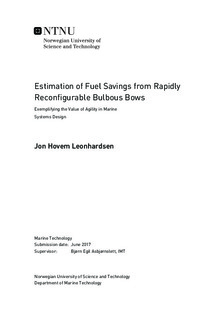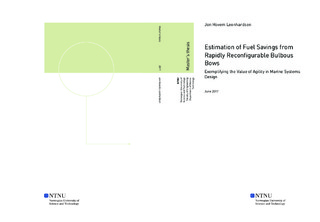| dc.description.abstract | This thesis analyzes the value of having geometrical bulbous bow flexibility in the context of sailing speed variability. The purpose of the bulbous bow, fitted on the foremost part of the hull, is to reduce wave-making resistance (an important fuel consumption-determinant) by the principles of destructive interference. Suboptimal containership bulbs have in the recent years received increased attention. The industry-wide adoption of slow steaming after the global recession in 2008 has entailed bulbs that operate off their intended design condition, yielding poor performance. Decreasing operating speeds have triggered a new design paradigm, where bulb design is conditioned on an average performance over a projected operating profile rather than to a specific design point. This approach is essentially a robust design strategy, accounting for context uncertainty without external interference during the life-cycle of the design object. However, the principles of average performance imply potential for further improvement, by incorporation of a dynamic bulb geometry that can adapt to the operating conditions.
The value of bulb flexibility is driven by the context uncertainty, which in this thesis is focused on sailing speed variability. Large amounts of historical speed records from Automatic Identification System (AIS) data were analyzed, and it became evident that significant variations can occur both during transits, and from transit to transit. As sailing speed during transit is bounded by technical and operational factors, the mean-reverting Ornstein-Uhlenbeck (OU) process was proposed as a stochastic representation of sailing speed. The underlying key assumption was that transit speed can be represented by three parameters; mean value, volatility and mean reversion rate. Parameters were estimated by running a regression on filtered transit time series for the entire Panamax containership segment, resulting in probability density functions (PDFs) representing possible transit speed dynamics. Sailing speed was simulated according to the OU process with transit-specific parameters sampled from the PDFs.
Resistance data for seven bulb configurations with constant cross-section, but different lengths, represented the flexible bulb. The option of switching between the associated fuel curves was the model representation of bulb reconfigurations. By combining sailing speed and resistance input, the aggregated fuel consumption was estimated with Monte Carlo simulations. The value of flexibility is derived from the option of minimizing fuel consumption by switching fuel curves, and the analysis was conducted with different time periods allowed between reconfigurations. The objective being to evaluate the value of agility, that is, the value of being able to rapidly reconfigure the bulb.
The value of agility was investigated through a case study calibrated to a reference ship similar to the KRISO Container Ship (KCS), for which resistance data was available. Bulb reconfiguration periods in the range between two hours and two weeks were analyzed, yielding average fuel savings in the range between 2.86% and 2.76%, respectively. The fuel consumption with bulb flexibility was compared to the original bulb of the KCS, and the fuel savings from agility had an upper bound of 3.7%, which was the maximum resistance reduction in the set of bulb configurations and speeds. The relatively modest difference between high and low agility is explained by the fact that two out of the seven bulb configurations covered the speed regime between 13 and 18.8 knots, speeds the reference ship holds 93% of the time.
It is concluded that the results leave few incentives for incorporating bulb flexibility, as fuel sav- ings from robust bulb retrofits are reported in the range between 5% and 10%. However, as flexibility in theory should outperform robustness, recommendations for further work include identification of valuable bulb flexibility, as this study only analyzed the value of adjusting the length parameter of the bulb. It is emphasized that the numerous assumptions, potentially uncertain input parameters and marginalization of certain fuel consumption-determinants make the analysis incomplete, underscoring that the results should be treated accordingly. | |

